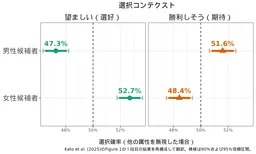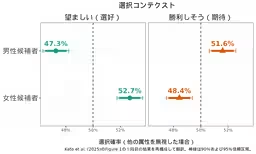

Unveiling the Invisible Barriers of Gender in Japanese Politics
Unveiling the Invisible Barriers of Gender in Japanese Politics
Recent research has shed light on a concerning phenomenon within Japanese politics: the stark preference among voters for female candidates, contrasted with the widespread belief that such candidates face lower chances of victory. This discrepancy, termed the "preference-expectation gap," reveals complex dynamics that may contribute to the ongoing gender disparity in political representation in Japan.
An insightful study conducted by researchers from Meiji University and Waseda University drew attention to the dichotomy between what voters desire personally and what they believe is realistically achievable in electoral outcomes. Despite a general liking for female candidates, voters are often hesitant to support them, as they suspect that others may not do the same.
Key Findings of the Research
1. Preference-Expectation Gap
The study highlights that many Japanese voters personally view female candidates favorably. However, there lies a gap between this personal preference and the expectation of success—voters believe that their peers will not vote for women, leading to reluctance in supporting female candidates. This gap suggests a form of "strategic discrimination," where individuals refrain from backing candidates they perceive as having little chance of winning.
2. Gender Bias and Strategic Discrimination
The findings also resonate with previous research conducted in the United States, which indicated that similar patterns of strategic discrimination exist. Psychology plays a pivotal role here. Voters, even with positive preferences for female candidates, may choose male candidates who they believe are more likely to win, thus perpetuating the low representation of women in politics.
3. Methodology of the Study
Utilizing online surveys and two rounds of conjoint experiments, the researchers created hypothetical candidate pairs differing in gender, party, age, and experience. Participants were asked to choose which candidates they found more desirable or which candidates they thought were likely to win. The results were compelling—while participants preferred female candidates in terms of desirability, their expectations skewed towards male candidates when it came to perceived chances of victory, revealing the pronounced nature of the preference-expectation gap.
Implications of the Research findings
These insights significantly contribute to the understanding of gender inequality within Japanese politics. It illustrates how, despite a lack of overt bias against female politicians, entrenched societal expectations inhibit their success. The authors posit that for meaningful change to occur, it is essential to not only boost the desire for female candidates but also to reshape the expectations around their likelihood of success.
Exploring the Preferences of Voters
The study also pinpointed that more liberal-leaning respondents and women themselves exhibited a larger preference-expectation gap. This suggests that even those who advocate for gender equality may unconsciously align their voting behaviors with traditional expectations surrounding political candidates. This behavior could unintentionally hinder the support for women candidates, creating a self-fulfilling prophecy in their underrepresentation.
Future Research Directions
Looking ahead, the authors urge for continued exploration into how the preference-expectation gap influences actual voting behavior. Understanding whether this pattern holds across different contexts and with other underrepresented groups in politics, such as minorities or younger candidates, can provide valuable insight.
Furthermore, the potential presence of similar gaps within political elites and decision-makers must also be probed, potentially influencing candidate selection processes in parties.
Conclusion
In summary, this research triumphantly uncovers the intricacies of voter attitudes towards female candidates in Japan, emphasizing a critical need for both societal and individual awareness to bridge the gap underlying gender inequality in politics. By acknowledging the preferences of voters alongside the expectations they hold, effective strategies can be designed to enhance the success of female candidates, thereby driving a much-needed change in the Japanese political landscape.

Topics People & Culture)










【About Using Articles】
You can freely use the title and article content by linking to the page where the article is posted.
※ Images cannot be used.
【About Links】
Links are free to use.